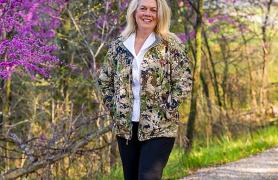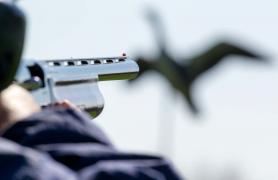A lifetime of being around animals, both domestic and wild, hasn’t reduced Sherri Russell’s passion for them one iota. In fact, it’s probably only intensified her interest.
And so, when MDC’s state wildlife veterinarian position opened, Russell knew she had to apply. Her ability to explain complex scientific concepts with stories, metaphors, and quite a bit of good humor helps in her daily job.
“This was a dream opportunity. I’m thrilled, completely thrilled, to be working for the wildlife and the citizens in Missouri,” she said.
As a kid, Russell helped her uncle provide medical care to the sheep, goats, and cattle he raised on his farm. Those childhood experiences inspired Russell to pursue a career in veterinary medicine, and in 1985 she graduated from the University of Missouri with a doctorate in veterinary medicine.
“He was always very kind to animals,” she said. “I felt, if that was what I did with my energies, it would be a good life.”
Many people assume, incorrectly, an average workday for Russell involves resetting a deer’s injured leg or administering antibiotics to a diseased hawk.
But that’s not what the job entails.
MDC encourages people to leave wild animals in the wild. This is especially true with young animals that may appear to have been abandoned. There are exceptions, of course, mostly dealing with endangered species. MDC has strict regulations concerning wildlife rehabilitation and relies upon a statewide network of private and nonprofit rehabilitators to heal injured mammals, birds, and reptiles.
“I try to practice population medicine by helping entire communities of animals,” she explained. “Instead of tending to individual animals, I’m tasked with caring for entire populations.”
Russell works with Missouri’s agricultural interests to prevent the transmission of diseases between wild and domestic animals.
“MDC has many partners to protect the state’s natural resources. These interactions are very important for the health of domestic and wild species,” Russell said.
She also supports MDC scientific researchers. At Peck Ranch in Shannon County, the veterinary care of the Missouri elk herd is mostly delivered by cervid biologists, but Russell collaborates with the researchers and offers advice.
“My involvement is really aimed at providing a veterinary perspective on the work they do,” she said.
A key responsibility is disease surveillance. Many diseases not only have implications for Missouri’s native wildlife, but also for domestic animals and people.
“Trying to understand where disease is on the landscape is job number one. We’re the first line of defense,” she said. “Seventy percent of all human diseases emerge from wildlife populations, so monitoring the presence of disease in wildlife is very important for human health.”
One Health
Russell is a proponent of the One Health concept, which recognizes that human health is inextricably linked with animals and the ecosystem. One Health asks the medical, scientific, conservation, and agricultural communities to collaborate to improve health for all species by accelerating biomedical research discoveries and expanding scientific knowledge.
“One Health is aimed at being collaborative, synergistic, enlightening, and cross disciplinary,” she explained. “For the natural resource professional, it offers a way of thinking that can enhance the mission of protecting fish, forests, and wildlife.” At a conference at Lake of the Ozarks in early March, she led a workshop titled Healthy Resources, Healthy You.
“Historically, natural resource scientists who worked with deer or fish did not have to know about epidemiology and were unlikely to attend a talk about One Health,” she said.
But that’s changing.
Helping the team of biologists who are managing deer for chronic wasting disease (CWD) — a prion disease first discovered in Missouri in 2012 — has been one of her highest-profile and most-challenging duties.
Holding up a necklace of knobby red beads, Russell — a teacher at heart, if not by profession — said the strand reminded her of a string of amino acids.
“When you buy a protein bar, it says ‘12 grams of protein.’ What does that mean?” she asked rhetorically. “What I’m showing you here is a rough model of a protein. Each bead is representative of an amino acid, which bind together to form long chains of proteins. Proteins are one of the building blocks of life.”
Well, they are until they aren’t.
In the early 1980s, scientist Stanley Prusiner discovered prions, a class of infectious self -reproducing pathogens primarily composed of proteins folding incorrectly on themselves.
“We know we have CWD prions. We know some prions are useful to animals, but we also know CWD prions aren’t good,” she said. “So how do you get rid of them?”
Unfortunately, scientists are still working to answer that question.
Russell remains optimistic. “It’s not hopeless,” she said. “On the horizon, there’s some really interesting science being done.”
Russell knows people are upset about CWD, and she’s urging them to remain calm.
“As Americans in 2018, we’re used to knowing. If we don’t know, we just type it into Google. But the fact that we don’t know everything about CWD is where our hope has to be. Scientific understanding is incomplete regarding prions. We don’t fully understand how the misfolding happens. But once we figure that out, we may be able to find a way to prevent it. So my general point is don’t despair,” she said. “There’s a lot of good research happening. We’re not where we’re going to be in five years.” She’s also working with leaders from a cross section of disciplines — agriculture, medical, conservation, science — to plan for the future. “We need to operate as if we’re going to get a solution,” she said. “How do we do that? We need to keep the prions off our land. We need to act like we own this disease and we’re going to win.”
Eighteen CWD-positive animals were removed from the landscape as a part of post-season targeted-culling operations this year, she noted. Culling accounts for 4 percent of all CWD samples collected so far but has resulted in finding 48
percent of Missouri’s CWD cases.
“That’s actually quite awesome. We’re not going to wipe this scourge away until we have a solution. But we have to keep our numbers low until then.”
Aquatic Health in Missouri’s Hatcheries
Russell, whose background is in private veterinary practice, works closely with MDC’s fish hatchery managers. It’s an unexpected aspect of her new job, but one she relishes.
Normally, MDC has an aquatic animal health specialist on staff, but the specialized position has been unfilled since November 2017. Until a new person can be hired, Russell has been serving in a support role.
“How the hatcheries operate has been a steep learning curve, but an exciting one,” she said. MDC hatcheries have been in production for more than 75 years and annually produce millions of fish. Since workers are exposed to the elements, it can be a tough, around-the-clock job. Floods, which inundated the hatchery buildings and forced trout out of the raceways, have only stressed the system more. Raising healthy fish is a bigger challenge than ever, she said.
Russell’s role involves helping with diagnoses and writing prescriptions when necessary. Parasites and bacteria exist naturally in reservoirs like Table Rock, which provides the fresh water for MDC’s Shepherd of the Hills Hatchery.
“When you’re dealing with high densities of fish in an intensive aquaculture operation, disease is easily moved,” she said.
But with concerns that bacteria-related diseases, such as furunculosis, are becoming increasingly resistant, veterinarians are far more frugal and exacting before prescribing an antibiotic.
As of January 2017, the U.S. Food and Drug Administration requires a veterinary directive to prescribe medicines for disease.
“That’s where Dr. Russell becomes instrumental,” explained James Civiello, Shepherd of the Hills Hatchery Systems manager, noting she’s been accessible for quick diagnoses. “She’s really developed a vet-client relationship with us. Sherri has saved us a lot of fish. We’ve seen less mortality because of the quick turnaround times.”
For her part, Russell said she’s been impressed with the hatchery teams’ dedication, noting they work in all kinds of weather, over weekends and holidays, to keep their operations successful.
“It’s phenomenal what they do,” she noted. “The managers are hardworking and the technicians are nothing short of magicians.”
Reverence for Missouri’s Abundance
Although she might not treat individual animals, the job still requires her to get out in the field regularly to meet with the biologists and technicians who do. There, she works to impart the knowledge she’s gleaned after more than 30 years in veterinary medicine.
“I can’t be everywhere all the time,” she said. “But I can pass on what I know.”
Not only does she teach the biologists how to keep themselves safe, she also advises them how to take the best care of the animals.
More than ever before, the public is sensitive to how animals are handled and treated. Whether a conservation agent is asked to respond to an injured fawn or a wildlife damage biologist is tasked with removing a nuisance beaver, Russell serves as a consultant, helping colleagues do their jobs in the most humane way.
“Our goal is to live kindly and considerately with the wildlife around us,” she said. “As I travel around the state, I have been continually impressed with the professional, kind people who make conservation their career.”
She’s committed to being a good steward of the natural resources in MDC’s care.
A 1937 wildlife survey found fewer than 2,500 turkeys and 2,000 deer remained in the state. Prairie chickens, ruffed grouse, beavers, otters, and raccoons were scarce. Elk and buffalo were gone. That early survey laid the groundwork for the conservation tasks ahead — restocking programs, carefully thought out and scheduled hunting seasons, and extensive habitat improvements.
“We know where we’ve been with Missouri conservation, and now we need to focus on where we’re going. CWD may pose a challenge to Missouri’s deer herd, but, overall, the herd is in good condition,” Russell said. “We need to continue our work.” A career working closely with domestic animals has deepened Russell’s reverence for Missouri’s wild species.
Rooted in Osage County, Russell feels conserving these natural resources for future generations is critical
“I want my grandchildren to be able to hunt, fish, and enjoy the wild spaces,” she said. “I wish people could just get outside and see the wonder of it all. Stewardship should be our guiding principle.”














Also In This Issue


And More...
This Issue's Staff
Associate Editor - Bonnie Chasteen
Staff Writer - Larry Archer
Staff Writer - Heather Feeler
Staff Writer - Kristie Hilgedick
Staff Writer - Joe Jerek
Creative Director - Stephanie Thurber
Art Director - Cliff White
Designer - Les Fortenberry
Designer - Marci Porter
Photographer - Noppadol Paothong
Photographer - David Stonner
Circulation - Laura Scheuler






















